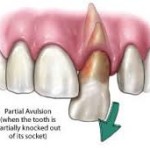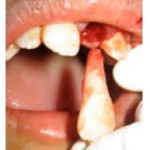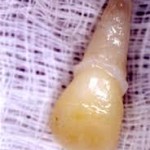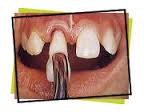The term Avulsion is used to describe a tooth that gets knocked partially or completely out of the socket. Accidents do happen and when you are in a situation like this, it helps to have a little knowledge of how to handle it. Many people panic and throw a knocked-out tooth away, but it can still be replanted if you follow these steps:
Immediately after the accident happens, look for the damaged tooth. If it is still in the socket, try to push it back to line it up at the same level as the adjacent teeth as possible, then seek professional help.
If the tooth is completely out of the socket, run it under the tap water to remove any contamination. The tooth then should be submerged into a glass of milk for a few minutes to help preserve the tissues. After that, it should be pushed back into the socket the same way described above and seek professional help. The sooner the tooth is put back, the better its survival rate.
Usually, this injured tooth needs to be splinted to other teeth and taken out of contact for at least six weeks before being reevaluated.
Patient instructions
- Avoid participation in contact sports.
- Soft food for up to 2 weeks.
- Brush teeth with a soft toothbrush after each meal.
- Use a chlorhexidine (0.1 %) mouth rinse twice a day for 1 week.
Ankylosis (fusion of tooth to bone) is unavoidable after delayed replantation and must be taken into consideration. In children and adolescents ankylosis is frequently associated with infraposition (immature teeth). Careful follow-up is required and good communication is necessary to ensure the patient and guardian of this likely outcome. The purpose of repeated follow-ups are for monitoring continued maturation of the root.
The goal for replanting still-developing (immature) teeth in children is to allow for possible revascularization of the pulp space. The risk of infection-related root resorption should be weighed up agains the chances of revascularization. such resorption is very rapid in children. If revascularization does not occur, root canal treatment may be recommended.



